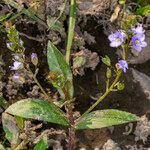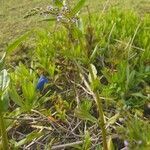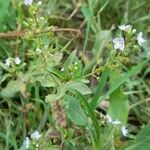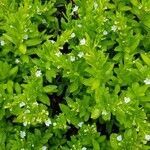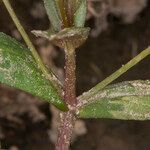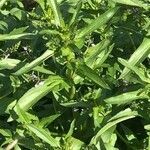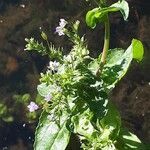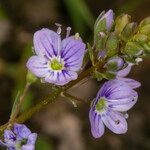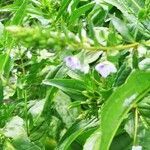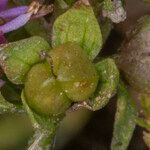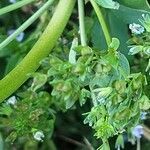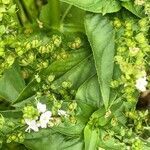Fibrous-rooted, probably biennial or short-lived perennial, ± erect, 2-10 dm, glabrous, or slightly glandular in the infl; lvs all opposite, mostly elliptic or elliptic-ovate to elliptic-oblong, sessile and mostly clasping (or the lower with subpetiolar base), 2-10 × 0.7-5 cm, 1.5-3 times as long as wide, sharply serrate to entire (sterile autumnal shoots with more rounded and petiolate lvs); racemes axillary, pedunculate, many-fld; sep highly variable in form and size; cor rather light blue, 5-8 mm wide; mature pedicels generally strongly ascending or upcurved, 3-8 mm; fr turgid, 2.5-4 mm, scarcely notched, nearly or fully as wide; style 1.5-2.5 mm; seeds numerous, 0.5 mm or less; 2n=36. Along ditches and slowly moving streams, or in other wet places, frequently in shallow water, but largely emersed; native of Eurasia, now established throughout our range. May-Sept. (V. glandifera) Hybridizes with no. 18 [Veronica catenata Pennell].
Annual or short-lived perennial herb, up to 1.2 m high; hydrophytic. Stems creeping, rooting at basal nodes, then abruptly erect, hollow, branched at base or above. Leaves with upper ones sessile, somewhat clasping, narrowly ovate to lanceolate, 50-100 x 5-20 mm; at least in distal half, lower ones petiolate, blade ovate or lanceolate-oblong, apex obtuse, margins ± entire or serrulate. Flowers: in axillary racemes up to 100 mm long; bracts reduced, lanceolate; pedicels < 10 mm long; calyx tube short, 4-lobed; corolla with tube short, 4-lobed, lower lobe shorter than others, blue-mauve or purple, rarely pink; Oct.-Feb., Apr. Fruit an ovate to orbicular capsule.
Annual or short-lived perennial, hydrophytic herb, up to 1.2 m high; stems creeping, rooting at basal nodes, then abruptly erect, hollow, branched at base or above. Leaves up to 100 x 20 mm, opposite, lower ones ovate or lanceolate-oblong, obtuse, petiolate, ± entire or serrulate; upper ones sessile, somewhat clasping. Flowers small, blue, mauve or purple, rarely pink, pedicellate, many in axillary racemes up to 100 mm long. Calyx: tube short, 4-lobed. Corolla: tube short, 4-lobed, lower lobe shorter than others. Flowering time Oct.-Feb. Fruit a 2-celled, ± globose capsule.
A short lived herb. It can be erect or lie along the ground. It grows about 50-150 cm high. The stems are often creeping and rooting from the lower nodes. The leaves do not have leaf stalks. Leaves are 5-15 cm long and 1-2 cm wide. They are narrow and oblong and can have teeth. The flowers are white or pinkish. They occur in lax, slender clusters. The number of clusters and flowers can vary greatly. The fruit is a capsule. It is compressed. It is 2-3.5 cm long. There are many seeds.
Brittle-stemmed, thinly glandular-hairy or glabrescent perennial to 50 cm, stem hollow, decumbent and rooting at lower nodes. Leaves opposite, sessile, ovate-lanceolate, serrate. Flowers in ascending, axillary racemes, white or pink to blue, 5-6 mm diam.
Annual or short-lived perennial, 300-600 mm tall, stems creeping to erect, weakly 4-angled. Leaves in opposite pairs, ovate-lanceolate, toothed. Flowers in elongated racemes, petals 4, pale blue, violet, pinkish or white, stamens 2.
Perennial herb, up to 1 m high. Flowers in axillary racemes. Upper leaves ovate to narrowly ovate, sessile. Pedicels erect, at least in distal half. Capsule ovate to orbicular. Flowers blue.
